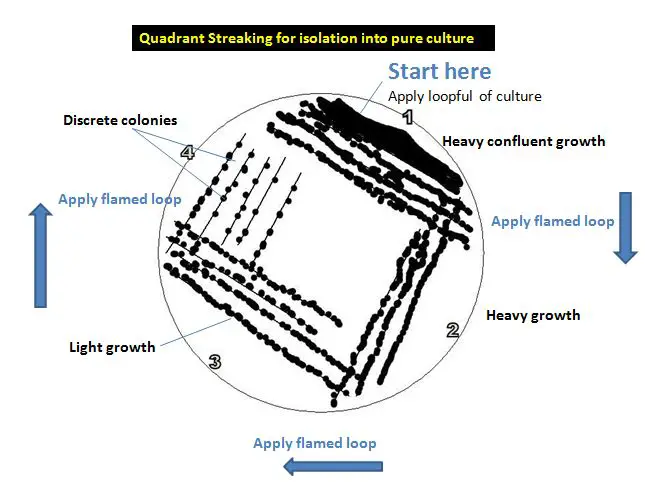Streak plate method: Principle, Purpose, Procedure and results


Streak plate technique is used for the isolation into pure culture of the organisms (mostly bacteria), from mixed population. The inoculum is streaked over the agar surface in such a way that it “thins out” the bacteria. Some individual bacterial cells are separated and well spaced from each other. As the original sample is diluted by streaking it over successive quadrants, the number of organisms decreases. Usually by the third or fourth quadrant only a few organisms are transferred which will give discrete colony forming units (CFUs).
Principle
The sample/inoculum is diluted by streaking it across the surface of the agar plate. While streaking in successive areas of the plate, the inoculum is diluted to the point where there is only one bacterial cell deposited every few millimeters on the surface of the agar plate. When these lone bacterial cells divide and give rise to thousands and thousands of new bacterial cells, an isolated colony is formed. Pure cultures can be obtained by picking well isolated colonies and re-streaking these on fresh agar plates.
Common assumption is an isolated colony of bacteria is the progeny of a single bacterial cell (i.e. colony is the clone). However, this is not necessarily true. With species in which the cells form a characteristic grouping during cell divisions, the colony forming unit may develop from a group of cells rather than form a single cell. For example, clusters of Staphylococci, chains of Streptococci etc.
Materials required:
- A source of bacteria (stock culture, previously streaked agar plate or any other inoculum)
- Inoculation loop,
- A striker/lighter
- Bunsen burner,
- Lysol (10%v/v)
- Agar plate (Nutrient agar or any other agar medium)
- Paper towels
Tips for the best results:
- Use only a small amount of inoculum
- Streak lightly so that you do not gouge the agar.
- Flame the loop after you streak each quadrant.
- Make sure surface of the plate is free of droplets of condensed moisture
Purpose of streaking
- To produce isolated colonies of an organism (mostly bacteria) on an agar plate. This is useful when we need to separate organisms in a mixed culture (to purify/isolate particular strain from contaminants) or when we need to study the colony morphology of an organism.
- To identify the organism: biochemical tests to identify bacteria are only valid when performed on pure cultures.

Procedure
- Sterilize the inoculating loop in the bunsen burner by putting the loop into the flame until it is red hot. Allow it to cool.
- Pick an isolated colony from the agar plate culture and spread it over the first quadrant (approximately 1/4 of the plate) using close parallel streaks or Insert your loop into the tube/culture bottle and remove some inoculum. You don’t need a huge chunk.
- Immediately streak the inoculating loop very gently over a quarter of the plate using a back and forth motion (see area 1 in the figure above).
- Flame the loop again and allow it to cool. Going back to the edge of area 1 that you just streaked, extend the streaks into the second quarter of the plate (area 2).
- Flame the loop again and allow it to cool. Going back to the area that you just streaked (area 2), extend the streaks into the third quarter of the plate (area 3).
- Flame the loop again and allow it to cool. Going back to the area that you just streaked (area 3), extend the streaks into the center fourth of the plate (area 4).
- Flame your loop once more.
Results
Streaked plate are incubated at 37°C for 24 hours. Examine the colonies grown in the plate carefully. All colonies should have the same general appearance. If there is more than one type of colony, each type should be streaked again on a separate plate to obtain a pure culture.